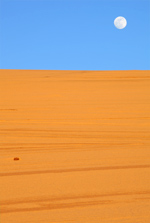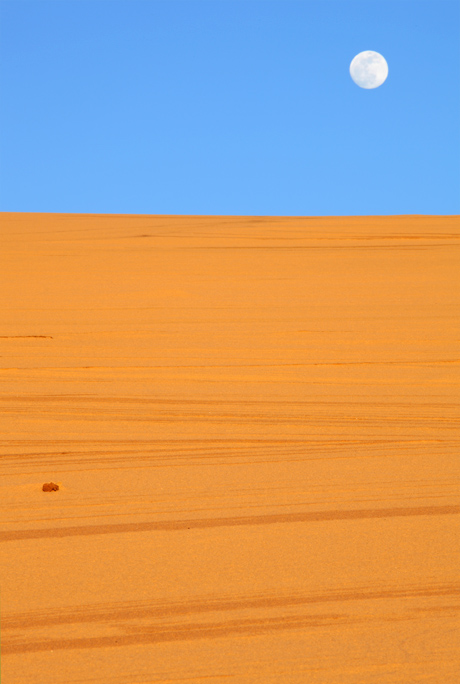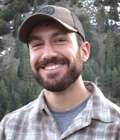
This time I want to talk about a photo I took last weekend while camping in the Mojave Desert. I intentionally picked this weekend because of the full moon–I was hoping to catch a few glorious moonrises and moonsets.
The first night I was there, I shot this photo a few minutes before sunset:

But, I see a few problems with how this photo came out:
- Moon is out of focus
- Lines in the sand are not emphasized enough
- Perhaps the moon is a little too small
Why is the moon out of focus?
It may not be very obvious from the small image above, but the moon in this photo is not in focus. Here’s a 100% crop that shows this more clearly:

Why did this happen?
Simple: the sand in the foreground was pretty close to the camera (around 15-20 ft), while the moon was significantly farther away. I focused about midway into the sand dune, and despite the small aperture I used (f/32), there still wasn’t enough depth of field to make the moon in focus. It was just too far away in relation to the close sand dunes.
One solution to this problem is to take two photos: one focused on the sand, and the other focused on the distant moon. Then, combine these images later in post-processing.
Why didn’t I do this? Why did I make such a simple mistake here?
Well, I actually arrived to these dunes pretty late, on the night I took this photo. I got there about an hour before sunset, and that didn’t give me much time to hike through the dunes and find a good composition for the sunset (and moonrise). I actually started running through the dunes at one point, trying to chase the sun before it set.
Since I was rushing so much, I got sloppy and forgot that I needed to take two separately focused photos for this image.
So, that’s lesson #1 here: don’t rush. Get to your photo location well before you plan to actually hit that shutter button.
How the sand could have looked better
I was pretty lucky to visit these dunes when I did. It had just rained on them earlier that week, and instead of those typical smooth waves you see in dry sand dunes, I got to see these beautiful thick lines of moist sand. It’s something you don’t see very often, and I should have emphasized them more in this photo.
I could have done this by getting closer and using a wide-angle lens, or getting higher so I could shoot them from above where these waves were most visible from.
Since my mind was so set on photographing the moonrise, I didn’t appreciate the unique conditions of the dunes nearly enough.
So, that’s lesson #2 here: although you may be set on photographing a specific landscape, always keep an open mind and be ready to adapt to any surprises you might find.
Is the moon too small?
I personally feel like the moon is also a little small in this photo, but this isn’t really a huge problem and I think it’s just a personal preference: I love images with a giant moon (like this awesome photo by Jim Goldstein).
To make the moon bigger in this image, I should have used a 300mm lens instead of the 70-200.
So, lesson #3 is: visualize your final image before snapping the photo, and know your lenses.
What went right with this photo
Although I think this is a “bad photo,” I’d like to end on a positive note and just say that a few things did go well with this shot:
- the light was glorious (thanks to the setting sun)
- the unique waves in the sand still look pretty cool even if they’re not emphasized enough
- I think I chose a good composition (with the sand making up most of the photo)
If you enjoyed this article, and would like to read more, please signup for free updates by email or RSS.
 About the Author: Steve Berardi is a naturalist, photographer, computer scientist, and founder of PhotoNaturalist. You can usually find him hiking in the beautiful mountains and deserts of Southern California.
About the Author: Steve Berardi is a naturalist, photographer, computer scientist, and founder of PhotoNaturalist. You can usually find him hiking in the beautiful mountains and deserts of Southern California.
Spot on post! I too felt inspired by some of Jim Goldstein’s recent moon shots to go out and try to capture a scene with the moon instead of just the moon. I’ve had great success with 70-200mm lens w/ 2x extender. I know many folks claim 2x extender will prevent tack sharp shots but I’ve great results with that combination. I couldn’t agree more with your lesson #1 – planning is everything. I recently shared a fun tip that I used to plan my latest moon image on Flickr: http://www.flickr.com/photos/unifiedphoto/4317212293/
I’ve spent a good amount of time looking at this photo and it finally hit me what makes it seem kind of odd to me. It’s obviously a landscape photo but it was shot in potrait mode. Was the original shot that way or did you choose to crop it this way in post processing? Knowing you shot this out in the desert where I would assume you have a pretty wide open canvas to work with this shot feels constrained to me. Kudos for getting the sand to fall on or near one of the rule of thirds intersections. That being said though I think there’s too much sand and not enough sky. Perhaps if you had 1/3 sand and 2/3 sky? You know what would be a fun exercise, post a copy of the original full size image and let us download and tweak it. I’ve seen this done on DPS and it’s pretty amazing to see the different ways folks tweak the same image.
Great Post! If we can’t be our own worst critic, then we’ll never grow as photographers.
A couple of things I wanted to point out —
You mentioned that you used an aperture of f/32. Using an super tiny aperture like that will cause diffraction, which manifests as an overall softness in the image. Diffraction is also more prominent near the edges of the sensor. So the moon would have been “soft” no matter if it had been in perfect focus or not. Also, the longer shutter speed required at f/32 leaves you more open to vibration disturbances from wind or your tripod shifting slightly in the sand.
Also, when using a telephoto lens, your depth of field is significantly decreased. So focusing halfway in the scene is not an applicable solution to a situation like that. Even though I’m somewhat of a photo purist, I like the method (you mentioned) of taking two separate images and combining them in post-production. In that situation, if you’re shooting 35mm-equivalent or smaller and using no T/S lens, then the 2-image or even 3-image method would be your best course of action.
That being said, above all photography should be enjoyable. So keep these technical aspects in the back of your mind, but don’t dwell on perfection with every image.
What was your shutter speed for the shot? With an aperture of f/32, presumably it was pretty slow, so the movement of the moon/earth could also be a factor in the blur, no? If you’re using a high ISO to speed up the shutter, then that could lead to loss of sharpness due to noise (looks like you have a bit of noise in the sand).
@Ken – Great moon shot! You captured a lot of detail in there.
@Zack – This shot was barely cropped. I cropped just a little off from the bottom (which was sand). I did take some shots like this that were horizontal, but they looked really weird to me, so I kinda like this vertical composition better. I really like simple landscape images like this, so I think it would’ve been okay if I had the moon larger and it was sharp.
Your idea of including more sky and less sand would definitely fall in line with the laws of color harmony, and I did try a few shots like that too, but for some reason whenever I look at those shots, I feel like I need to push up the sand like it’s not covering enough of the photo. I like your idea about sharing the original file, so I’ll plan to do that for the next post like this, thanks for sharing that 🙂
@Eric – I’ve always thought that being my own worst critic has helped me grow in photography more than anything else. I really only have like 4 photos that I really think are great, so that strong self-criticism has really helped motivate me to improve.
Anyway, you make a lot of great points. I’m not sure if diffraction was a huge problem though: the smallest aperture on that lens is f/45, so I was still a little under that (which I did on purpose). I should do more research on this lens though to find out where diffraction becomes a problem.
But, I agree that the shutter speed could have definitely contributed to the problem. I didn’t think of that before you mentioned it, so I just realized it was shot at 1/5, which might be a little slow for the moon.
I agree, photography should always be enjoyable 🙂 And, I did have fun that night even if I didn’t capture it as I would have liked. Hiking through dunes at sunset, and especially after sunset is always glorious (with or without a camera) 🙂
@Dave – I shot this at 1/5, and I didn’t really consider that until now. I think that’s a little too slow for the moon, so that definitely could have helped cause the problem too. Thanks for pointing this out!
Steve,
Did you get a new camera? For kicks I downloaded this photo and loaded it up into DPP and the EXIF information shows it was shot with a 5D Mark II. What’s up with that?? If you did shoot this with the 5D Mark II how did you like it? I have the original 5D and love it.
@Zack – yeah, I caved in a few months ago and bought a 5D Mk II 🙂 It really was a tough decision (seriously), but after a lot of thought, I decided I really wanted to start shooting wide angle landscapes, and the big sensor is better for some close up shots like wildflowers (which is one of my favorite subjects).
I’d also like to get into making short films of stuff I see (i.e. hummingbirds collecting nectar from flowers), so I went ahead and bought that awesome camera. I’m loving it so far, and it’s amazing at higher ISOs (I can shoot at ISO 800 without any noticeable noise–awesome!).
Steve a great idea for a write up. I enjoyed reading this and of course am honored that you referenced one of my photos as a point of inspiration. i wanted to share a thought that has yet to be mentioned…
The moon does not have to be tack sharp.
It’s pretty easy these days to expect that everything be super sharp in the frame. When you’re dealing with a subject that is near (relatively) and one that is 238,000 miles away (the moon) its seldom the case. In fact much of what we think is sharp in photo backgrounds is often an illusion. Sharp foregrounds provide a clear anchor of focus and provide a lasting mental image that we then bleed over in relation to other background elements. This isn’t always the case, but for subjects that take up a smaller portion of an image like the moon it is often the case.
That being said there are things you can do to get the moon as sharp as possible:
1. Focal Length
A longer focal length is going to help magnify the moon. Balanced with the right foreground element you can create some rather dramatic images.
2. Shutter Speed
The moon is a sun lit object so finding the right time of day and using the Sunny 16 rule as a starting point you can get some sharp photos when photographing the moon in the early morning/evening. 1/5th of a second is too short to get optimal sharpness of the moon in the scenario you took this photo.
3. Optimal Aperture Balancing DoF & Sharpness
This was discussed prior… shooting at the smallest aperture can soften your image, but given other factors may not be the only reason for softness of the moon.
4. Conscious of Atmospheric & Heated Air Distortion
You were in the desert so beyond normal atmospheric distortion that may have lost sharpness due to heated air distortion. With the moon low enough on the horizon and if the sand was hot enough you could have been shooting through heated air distortions (similar to mirage like distortions you see above hot pavement).
5. Use Mirror Lockup
Minimizing vibration of the internal working of your camera is a sure fire way to minimize risk to introducing softness of your subject.
6. Use a Cable Release
The longer the lens the greater impact slight movements will have to the sharpness of your image. Using a cable release will help take you out of the equation in negatively impacting image sharpness.
As for composition. I think the bottom square of your photo is a great abstract. Leading lines or complimentary subjects always help with moon photos. Food for thought the next time you go out looking to get your moon photo.
@Jim – wow, thanks for that great response!
I didn’t realize it before you mentioned it, but I agree, that the moon doesn’t need to be tack sharp. I think it just needs to be at the very least “recognizable”
You made a really interesting point about sharp foregrounds creating the illusion of sharp background elements. I never thought about this before. And, now that I think about it, I have a few images where this is definitely the case.
Your point #4 is also very interesting.. even though I was aware of such natural phenomena, I never thought about heated air distortion while taking photos before.
It’s funny you mention the bottom square as an abstract, cause when I first opened this photo, that’s exactly what I did: crop the bottom. It looks okay, but I think it would’ve been better if I got closer with a wide-angle lens for that type of shot.
Sometimes I think it all comes down to personal taste and photographic style. To me if the moon was completely in focus, I would question weither it was just added digitally after the fact. I personally appreciate the photos that have not been digitally altered, other than basic touch ups. A big part of photography is like what you described above. Planning the photo out, taking the time to think about the composition you want, and then waiting for the right moment. That says a lot about a person’s talent as a photographer. I tend to gravitate more to photos that have a genuine feel to them.
But again that is personal preference as well.
F32 is a way too small! Photo goes worse if you use smaller than F11.
Use hyperfocaldistance!
Thanks! I’ve always wondered the best way to accomplish this, now I just need to find the time to go out & shoot some pics! 🙂
Found this useful, thank you. I’m working in El Centro, took some shots of dunes on the west side of Salton sea, can’t wait to get over to the imperial dunes and see what I can do! and I have been thinking about sun at sunrise and perhaps moon. so thanks